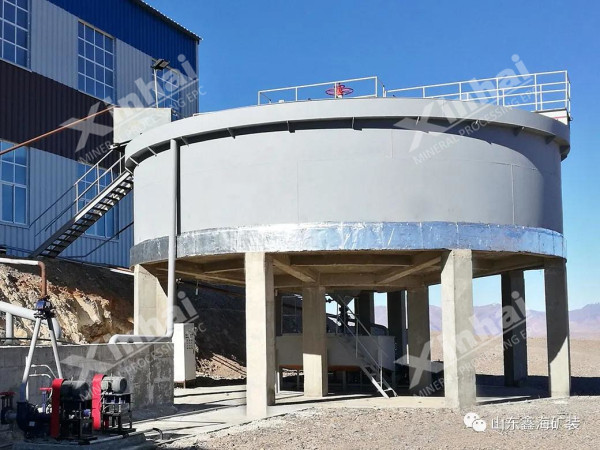Gold ore carbon in leaching (CIL) process is a process of adding activated carbon to pulp and simultaneously leaching and adsorbing gold. It is one of the main methods of gold beneficiation at present. The process is developed on the basis of the carbon in pulp method (CIP), which combines the two steps of cyanidation leaching pulp and activated carbon adsorption into one. So CIL has some advantages, including less leaching tanks, shorter process flow, and lower infrastructure investment and production cost.
Generally, the process of gold ore extraction by carbon leaching (CIL) mainly includes six stages: pulp impurity removal, concentration before leaching, leaching and adsorption, desorption electrolysis, pyrometallurgy, and activated carbon regeneration.

Before the leaching and adsorption of cyanide pulp, it is necessary to remove impurities such as sawdust in the pulp, so as to prevent the impurities from adsorbing the gold in the pulp, and preventing it from mixing into the rich carbon to block the pipeline and carbon screen. When necessary, the pulp should be concentrated, and a descaling agent should be added. The descaling agent can reduce the scaling on the surface of the activated carbon and on the screen.

Under normal circumstances, an impurity removal operation is set up before the concentration and after the grinding, and the intermediate frequency linear vibrating screen is often used as the impurity removal equipment. The screen size is selected as small as possible on the premise of ensuring that the screen surface does not run away.
The concentration of pulp will not only affect the leaching time, but also affect the suspension state of activated carbon. Therefore, in order to make the pulp reach a suitable leaching concentration, the pulp needs to be dewatered by a thickener before leaching.
When the overflow concentration of grinding and classification is 18-22%, it is not suitable for direct leaching, and the pulp must be concentrated first. At this time, it is recommended to use a high-efficiency thickener with a small footprint and high concentration efficiency.

An obvious feature of the gold ore carbon in leaching (CIL) process is that the leaching and adsorption operations of gold are carried out at the same time. And the specifications and number of leaching tanks need to be determined according to the processing capacity of the gold ore dressing plant.
The impurity-removed and concentrated ore pulp is driven into high-efficiency leaching tanks in a stepped arrangement. Generally, 5-12 leaching tanks are arranged in series. Cyanide is added to the first one or two leaching tanks, and activated carbon is added to the latter leaching tanks. Since sodium cyanide has just been added to the first one or two tanks, the amount of leached gold is small, so most gold ore carbon leaching plants use the first one or two leaching tanks as pre-leaching tanks, and the latter leaching tanks are leaching adsorption tanks.
Generally, each leaching tank is equipped with a carbon screen to separate activated carbon and pulp. Activated carbon and pulp are adsorbed in countercurrent flow, fresh activated carbon is added from the last leaching and adsorption tank, and gold-loaded carbon is discharged from the first leaching and adsorption tank. Activated carbon becomes carbon loaded with gold due to the adsorption of gold in pulp. After the adsorption operation is completed, the pulp containing gold-loaded carbon is sent to the carbon extraction screen through the air lifter to separate the pulp and activated carbon. After sieving and washing, the pulp is sent to the desorption electrolysis operation. The gold grade of the pulp solution after adsorption by this method is generally 0.01-0.03g/m³.

At present, the desorption method of gold-loaded carbon commonly used is high temperature and high pressure desorption method. To be specific, under the condition of high temperature and high pressure, anions that are easily adsorbed by activated carbon are added to the desorption system, and Au(CN)2- is replaced to obtain gold mud and barren carbon, so as to achieve gold desorption.
The pregnant solution obtained by desorption of gold-loaded carbon is recovered by ionization method to obtain solid gold.
In production practice, most gold ore carbon leaching plants use pyrometallurgy process, where gold ingots are directly smelted from gold mud obtained through simple pickling and impurity removal operations. After pyrometallurgy, the purity of gold ingots can reach more than 99.99%.

The activated carbon after adsorption and desorption needs to be regenerated to restore its adsorption performance. Usually, after desorption, activated carbon is acid washed to remove carbonate and other accumulations. After repeated use, it needs to be thermally activated to restore the adsorption activity of activated carbon, and then it can be recycled again. The equipment required for activated carbon regeneration operation mainly includes activated carbon pickling tank, neutralization tank, regeneration kiln, fine carbon separation screen, water quenching tank, etc.
Gold ore carbon leaching (CIL) process has strong adaptability to gold ore and is suitable for most types of gold ore. In production practice, it is recommended to do a beneficiation test, and determine scientific and reasonable technological process and technical parameters according to the results of the beneficiation test. Random application or simple copying from other mineral processing plant is unadvisable.